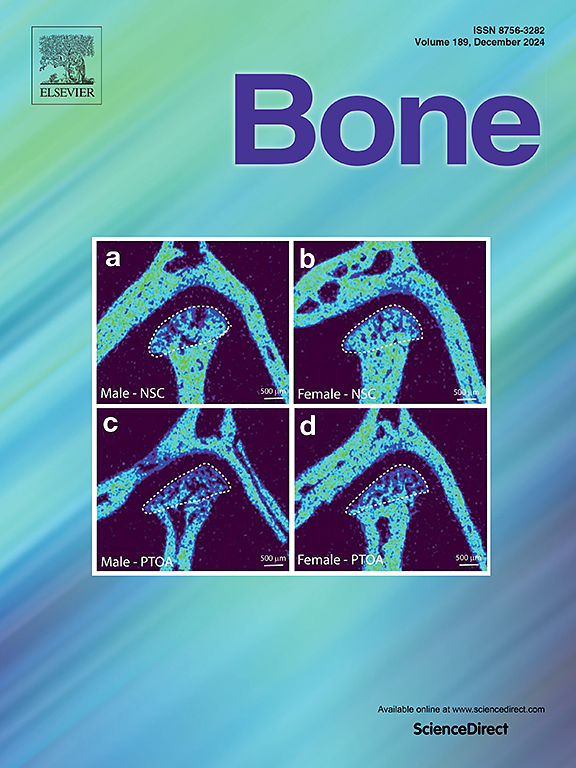特立帕肽对骨密度、骨小梁评分和相对于髋部总t评分的骨折风险的长期影响:一项为期20年、基于登记的队列研究
IF 3.5
2区 医学
Q2 ENDOCRINOLOGY & METABOLISM
引用次数: 0
摘要
背景:特立帕肽后抗吸收治疗显示骨折减少疗效长达2年,但尚不清楚这是否会导致骨密度(BMD)和骨小梁评分(TBS)的持续增加,以及BMD是否与骨折风险降低相关。方法在这项多中心队列研究中,对参加瑞士骨质疏松症登记的患者进行了为期18-24个月的特立帕肽治疗和抗吸收治疗的效果评估。在服用特立帕肽前后10年测量BMD和TBS。结果2004年5月至2023年12月共纳入624例患者,其中女性87%,年龄67±13岁。其中,198例(32%)患者在使用特立帕肽之前未接受过治疗,426例患者之前接受过抗吸收治疗(中位持续时间5.9年[2.2,8.0])。所有患者随后都接受了抗吸收治疗,主要是双磷酸盐和地诺单抗。在开始使用特立帕肽前2年内,椎体、髋部和任何部位骨折的发生率分别为0.96、0.11和1.37。髋部总t评分与特立帕肽治疗下骨折复位无关。从特立帕肽过渡到抗吸收方案后,与治疗前相比,特立帕肽治疗后长达5年的骨折发生率仍然较低,骨密度显著升高(腰椎t评分+ 0.876,p <;0.001;全髋+ 0.112,p <;0.005), TBS升高0.047 (p <;0.001)。总体而言,在接受特立帕肽治疗的预处理和treatment-naïve患者中观察到显着改善。结论:在治疗前和treatment-naïve患者改用抗吸收药物后,特立帕肽可使椎体、髋关节和其他部位骨折的发生率持续降低长达8年。此外,BMD和TBS水平显著高于特立帕肽治疗前。在特立帕肽治疗期间,髋部总t评分与骨折风险无关。本文章由计算机程序翻译,如有差异,请以英文原文为准。
Long-term impact of teriparatide on bone mineral density, trabecular bone score, and fracture risk relative to total hip T-score: A two-decade, registry-based cohort study
Background
Teriparatide followed by antiresorptive therapy exhibits fracture reduction efficacy for up to 2 years, but it remains unclear if this leads to sustained increases in bone mineral density (BMD) and trabecular bone score (TBS), and if BMD correlates with fracture risk reduction.
Methods
In this multicenter cohort study, the effect of teriparatide administration for 18–24 months, followed by antiresorptive therapy, was assessed in patients partipicipating in a nationwide Swiss osteoporosis registry. BMD and TBS were measured up to 10 years before and after teriparatide initiation.
Results
A total of 624 patients (87 % female, age 67 ± 13 years) were enrolled from May 2004 to December 2023. Among them, 198 (32 %) received no treatment prior to teriparatide, while 426 had received previous antiresorptive therapies (median duration 5.9 years [2.2, 8.0]). All patients underwent subsequent antiresorptive therapy, mainly with bisphosphonates and denosumab. The incidences of vertebral, hip, and any fractures were 0.96, 0.11, and 1.37, respectively, within 2 years prior to teriparatide initiation. The total hip T-score did not correlate with fracture reduction under teriparatide. After transitioning from teriparatide to an antiresorptive regimen, fracture incidence remained low and BMD was significantly higher for up to 5 years after teriparatide compared to the pre-treatment period (T-score + 0.876 for lumbar spine, p < 0.001; and + 0.112 for total hip, p < 0.005), while TBS increased by 0.047 (p < 0.001). Overall, significant improvement was observed in pretreated and treatment-naïve patients undergoing teriparatide treatment.
Conclusion
Teriparatide led to sustained lower incidences of vertebral, hip, and other fractures for up to 8 years after switching to antiresorptive agents in both pretreated and treatment-naïve patients. Additionally, BMD and TBS levels were significantly higher than those before teriparatide treatment. During teriparatide treatment, the total hip T-score did not correlate with fracture risk.
求助全文
通过发布文献求助,成功后即可免费获取论文全文。
去求助
来源期刊

Bone
医学-内分泌学与代谢
CiteScore
8.90
自引率
4.90%
发文量
264
审稿时长
30 days
期刊介绍:
BONE is an interdisciplinary forum for the rapid publication of original articles and reviews on basic, translational, and clinical aspects of bone and mineral metabolism. The Journal also encourages submissions related to interactions of bone with other organ systems, including cartilage, endocrine, muscle, fat, neural, vascular, gastrointestinal, hematopoietic, and immune systems. Particular attention is placed on the application of experimental studies to clinical practice.
 求助内容:
求助内容: 应助结果提醒方式:
应助结果提醒方式:


